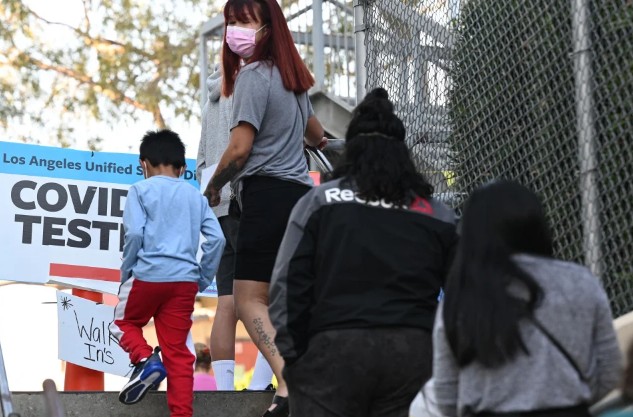Parents scramble to test their children as COVID hits schools, or face a return to remote learning.
Eddie, Kendra Levine’s 5-year-old son, immediately comprehended the relevance of the COVID-19 rapid tests he took at home last weekend, despite the fact that he is only 5 years old.
Eddie could return to school and visit his pals after two weeks away because of the tests, which were issued by the Berkeley Unified School District in California before pupils went on winter vacation. Most importantly, they meant Levine could send him to school with more confidence on Monday.
«He was overjoyed to present it to us,» recalls Levine, whose kid has become accustomed to pandemic drills over the last two years. «This has shaped the majority of his recollection for the past two years.» ‘We have to wear masks and stay away from those who aren’t wearing masks,’ she explains. «We keep assuring him, ‘We’re doing our part to keep other people safe,'» said the group.
COVID-19 cases fuelled by the Omicron variation are on the rise as kids return from Christmas break this week, complicating attempts to keep school facilities open and students and staff safe. Students in certain districts are required to present documentation of a negative test. Others have returned to remote learning due to staff absenteeism and high infection rates in the community.
As parents, students, and school personnel strive to acclimate to what is shaping up to be another semester dominated by pandemic fears, the overall picture is one of confusion. There are countless families facing school closures or scrambling to find COVID-19 examinations on their own in the hopes of bringing their children back to class for every family with access to home tests.
Before classes resumed on Thursday, all 51,000 public school pupils in Washington, D.C., were required to present documentation of a negative COVID-19 exam. In New York City, where the new mayor, Eric Adams, has pledged to keep schools open, officials have expanded random in-school testing and announced that every student and staff member in a classroom where someone tests positive will receive at-home quick test kits.
California administrators had promised to deliver at-home COVID-19 tests to the state’s 6 million K-12 pupils, anticipating a viral outbreak during winter break. According to the Los Angeles Times, just about half of those tests had been sent to districts by the time several schools reopened on Monday.
When Minneapolis Public Schools sent out an email on Dec. 30 asking families to «take the extra step of getting tested for COVID-19 before returning to school on Jan. 3,» parent and epidemiologist Rachel Widome says the «Covid Test Hunger Games» began, with parents sharing tips on Facebook groups for finding rapid tests at drug stores. A link to community testing locations was supplied by the district, but many people were overwhelmed by long waits.
Even in cities where tests were available, such as Berkeley, many families did not report their results. The district gave test kits to about 12,000 students and staff members, inviting them to take the test on Dec. 31 and again on Jan. 2. Nearly 230 positive instances were discovered among the 64 per cent (7,687 persons) who reported their test results, yielding a positivity rate of 2.95 per cent.
Still, that was enough to reassure the district superintendent, Brent Stephens, who claims that the positive results allowed district leaders to limit the viral spread in schools and to safely isolate those who had tested positive.
Stephens expects that the take-home tests, in combination with regular in-school testing, mandatory masks, and COVID-19 immunization for those above the age of 12, will help keep schools open for pupils.
This is crucial, he believes, in order to avoid even more learning loss and social hardship during the 2020-21 school year’s lengthy school closures.
On January 5, 2022, masked pupils in an art class at Yung Wing School P.S. 124 in New York City. Despite high student and teacher absenteeism rates due to the spike of Omicron cases, Mayor Eric Adams is keeping classrooms open for in-person lessons.
«It’s where they’re supposed to be.» It’s the best place for them to be. It’s where they’ll be able to grow up. «We saw a lot of despair, mental health concerns, feelings of isolation, and missed possibilities for development as a result of that extended time of distance learning,» Stephens adds. «As a community, we all feel a great duty to keep schools open and ensure that youngsters don’t miss out on those essential experiences again.»
However, the price of oil is growing. COVID- For districts around the country, 19 cases have made this difficult. Staff absences in Stephens’ district reached «a level we’ve never seen» this week, with 65 employees absent on Tuesday and just roughly 25 substitutes available. To cover those absences, the district is considering deploying office personnel who are trained to teach in classrooms.
In Chicago, the school was cancelled on Wednesday and Thursday after teachers voted not to report to school buildings and called for remote learning in the face of rising coronavirus cases, requesting that the district expand COVID-19 testing before they returned.
However, a nationwide testing scarcity persists.
Widom, an epidemiologist at the University of Minnesota whose 4-year-old son attends Minneapolis Public Schools, had already purchased fast tests and had some on hand, but she recognizes that she is an outlier.
«Given the testing deficit, that’s certainly an unattainable ask for a lot of families,» Widome adds. «There are probably numerous people in schools now — both students and staff — who would not be in school if they had access to a test.» And those are the kinds of scenarios that could launch new infection chains.»
President Joe Biden has committed to expanding access to testing and has launched a proposal to deliver 500 million free at-home quick test kits to Americans. However, without those reinforcements, school resumed this week.
«This ought to be simple. To be able to access these exams, you shouldn’t have to devote time, money, intellectual activity, or be well-connected,» Widome explains. «We must make it simple for people to do the right thing.» We must make it as simple as possible for folks to be tested. And we’re making it extremely difficult right now.»
Wisdom considers every day her kid spends in school a win, but she is concerned about the possibility that he will contract COVID-19 despite being vaccinated and adept at wearing a mask. And she’s unhappy that nearly two years into the pandemic, the simple act of taking her child to school remains so stressful.
«I have some bitterness that I and others are in this situation, that leadership has let us down so badly that two years later, I have to worry about putting my child to school,» she says. «I’d have assumed we’d be in a better position by now.»






Be the first to comment on "Parents scramble to test their children as COVID hits schools, or face…"